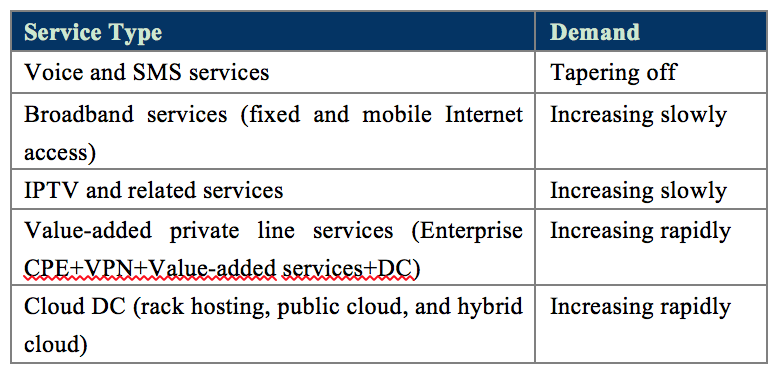ICT development accelerates innovation. Enterprises need efficient, reliable, elastic ICT services for quicker market expansion, more agile innovation, and higher productivity.
Strategic Opportunities for Operators in an ICT Transformation
Growth in traditional operator services is plateauing. The demand for voice, SMS, and video call services has been gradually decreasing. The growth in broadband (both fixed and mobile Internet access) and IPTV services has also been slowing down after years of development. In contrast, enterprise demands for new VPN services and cloud data center (DC) services have been rapidly increasing.

There are new opportunities in ICT cloud services. The vision is to provide easily accessible IT services for enterprises. Think about how easily you access electrical power. The wires in your home are connected to a power plant, and you enjoy high-quality electrical services without having to buy your own generator. Enterprise IT services are similar. A cloud computing service provider builds large-scale IT cloud infrastructure, providing computing, storage, and various value-added services through the Internet (VPN). Enterprises can enjoy professional, high-quality, pay-per-use, and elastic IT services without the effort to build their own IT infrastructure.
With comprehensive network resources, operators can provide enterprises with one-stop CloudVPN services, such as E2E VPN, on-demand cloud service, and elastic and customizable value-added services. The “Cloud+VPN” service mode will change the way enterprises consume ICT resources. An enterprise can enable cloud and network VPN services with ease, and enjoy high-quality ICT cloud services. With advantages in operating E2E network resources, operators can explore the trillion-dollar enterprise ICT market as service access providers, boosting growth and discovering strategic opportunities.
The benefits are tempting but not easy to acquire. Operator business systems have been “siloed” for decades, with different vendor equipment and business management systems used in different product domains. To launch a new function or service, an operator needs 12–24 months for technical selection, product development by vendors, integration verification, live network deployment, etc. To provision a service, the operator needs another 15–45 days for the coordination of different domains, technologies, and vendor resources, and for segment-by-segment service provisioning across systems and departments.
Challenges arise when operators try to integrate clouds and network services and service supporting systems, lay a foundation for one-stop enterprise CloudVPN services, transform siloed networks, and accelerate private line service launching.
Huawei SDN System Integration Helps Operators Provide One-Stop Enterprise CloudVPN Services
SDN provides a new idea in addressing these challenges. Huawei has decades of experience and accumulation in telecom technologies. Armed with the deep understanding of WAN, DC, and value-added service features, when dealing with common problems in operator service systems and supporting operator network reconstruction and integration, Huawei uses a combination of three approaches: SDN WAN network evolution; the pre-integration and modeling of value-added services; and unified ICT resource orchestration. With Huawei’s SDN Open Lab and Planning & Simulation platform, Huawei provides SDN system integration services that help operators transform their traditional siloed networks with SDN technologies, and enables the coordination between cloud and network operators to provide enterprises with one-stop CloudVPN services featuring on-demand flexible pricing, rich value-added services, service deployment within just minutes, and online self-service experience.
- Approach 1: SDN WAN Network Evolution to Accelerate Service Launches and Improve Service Capabilities
Taking operators’ huge inventory into consideration, Huawei believes the SDN evolution of operators’ traditional WAN networks should be hierarchical and progressive. Huawei SDN WAN services include Overlay and Underlay solutions, helping operators accelerate service launches and improving services overall.
Overlay Solution: Accurate Design to Quickly Establish E2E Connections
In the Overlay solution, an operator’s original network remains almost unchanged but is overlaid with a software-defined logical network, through which service logics are implemented. Overlay technologies allow operators to support new cloud services with their original network architecture, taking advantage of historical investment, and facilitating new service deployment. The Huawei Overlay solution can be used with the equipment of over 10 industry mainstream vendors, and supports topology restoration and capacity analysis for networks with over 10 thousand nodes. Huawei accurately identifies resource bottlenecks, forecasts future service growth, develops an optimal Overlay solution, and quickly establishes E2E connections.
Underlay Solution: Multi-Layer Coordination Design to Improve Service Capabilities by 30%
Reconstructing live network hardware, the Underlay solution adopts SDN architecture, integrates IP/MPLS and optical backbone networks, simplifies network O&M, enhances network intelligence and automation, and effectively coordinates IP and optical networks. This solution was used for operator T’s subsidiary in country P. Huawei developed an IP+Optical joint planning solution that contained the coordination planning of topology, capacity, and service protection, helping the customer improve planning efficiency by 50% and resource utilization by 30%. The result was highly appreciated by the customer.
- Approach 2: Pre-Integration and Modeling of Value-Added Services to Provide the Most Competitive Value-Added Services in the Industry
An operator needs to perform integration verifications every time it introduces in a new value-added service. A traditional network is tightly coupled with its service system, and the introduction of a new service requires interconnection between and code development for the business system and dozens of interfaces on many related nodes. The interconnection is time- and labor-consuming and too slow to satisfy market demands.
Quick Value-Added Service Pre-Integration
Huawei pre-integrates industry mainstream partner value-added services. With the support of the Huawei SDN Open Lab in Beijing, Huawei can integrate a new value-added service within seven days, creating a best practice for the field. So far, Huawei has established cooperative relationships with over 20 mainstream value-added service providers, has provided over 50 types of typical value-added services, and performed E2E service solution verifications for over 30 market projects around the world. The pre-integration helps operators quickly provide optimal low-cost value-added services for enterprises, wining high recognition from operators and partners alike.
NEMO to Quickly Customize Service Templates for Enterprises
Service customization and innovation are very important to and difficult for operators. Traditional northbound interfaces model network equipment from the bottom up. The interfaces are complicated and hard to use or standardize for service development. For convenient service customization, Huawei developed Network Modeling (NEMO), a next-generation network programming language. Using universal network operation modes and application-centered network models, NEMO models network equipment from the top down, allowing operator business designers to easily customize network service templates. NEMO is well suited to the different goals of different industries. Huawei puts NEMO into practice, analyzing operator enterprise businesses to summarize six typical business scenarios, and using NEMO to work up over 20 different standard network models. The models have been included in Huawei SDN cloud DC solutions and are promptly updated, significantly simplifying service design and accelerating service innovation and deployment.
- Approach 3: Unified ICT Resource Orchestration to Implement Convenient Enterprise Self-Service
Huawei ICT cross-domain service orchestration includes SDN network service and resource orchestration covering Underlay and Overlay solutions; DC cloud service and resource orchestration (DC-oriented unified resource allocation and the orchestration of cloud computing, storage, vDC and other cloud services); and unified ICT resource orchestration across networks and clouds. An operator can provide customizable enterprise portals and let enterprises apply for cloud, VPN, and value-added service resources on demand. Resources are provided immediately once subscribed to, and support convenient enterprise self-service, including dynamic online loading, deletion, and capacity scaling.
Dedicated to SDN Innovation to Develop Together with Operators
Seizing opportunities for future network transformation and innovation brought about by SDN technologies is fundamental to operators’ infrastructure transformation. Huawei can provide operators with customized integration services and comprehensive technical support with its continuous SDN investment and global SDN expert resources, including over 20 senior system architects, over 100 system architects, and more than 2,000 professional service engineers.
Huawei actively promotes open cooperation in SDN integration services, establishing a win-win SDN ecosystem in cooperation with industry partners and developers, such as operators, standard organizations (ONOS and ODL), and OTTs. Huawei is also dedicated to SDN open ecosystem-based innovation to quickly meet customer demands and facilitate SDN industry maturation.

